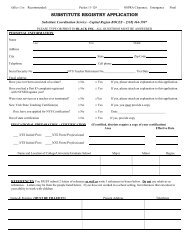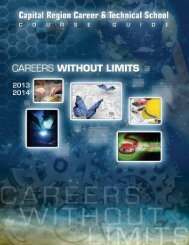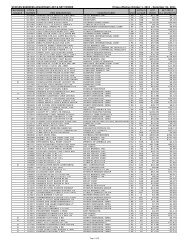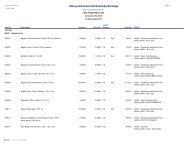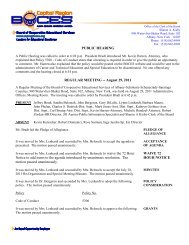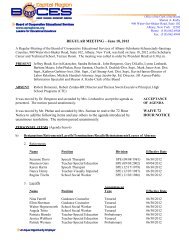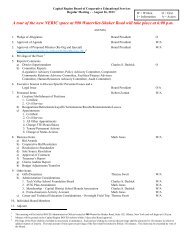Rubrics for Professional Practice - the State Board of Education
Rubrics for Professional Practice - the State Board of Education
Rubrics for Professional Practice - the State Board of Education
You also want an ePaper? Increase the reach of your titles
YUMPU automatically turns print PDFs into web optimized ePapers that Google loves.
THE FRAMEWORK FOR PROFESSIONAL PRACTICE 61<br />
DOMAIN 1: PLANNING AND PREPARATION<br />
Component 1e: Designing Coherent Instruction (continued)<br />
Elements: Learning activities • Instructional materials and resources • Instructional groups • Lesson and unit structure<br />
L E V E L O F P E R F O R M A N C E<br />
ELEMENT<br />
UNSATISFACTORY BASIC PROFICIENT DISTINGUISHED<br />
Lesson and unit<br />
structure<br />
The lesson or unit has no<br />
clearly defined structure, or<br />
<strong>the</strong> structure is chaotic. Activities<br />
do not follow an organized<br />
progression, and time<br />
allocations are unrealistic.<br />
The lesson or unit has a recognizable<br />
structure, although<br />
<strong>the</strong> structure is not uni<strong>for</strong>mly<br />
maintained throughout. Progression<br />
<strong>of</strong> activities is uneven,<br />
with most time allocations<br />
reasonable.<br />
The lesson or unit has a<br />
clearly defined structure<br />
around which activities are<br />
organized. Progression <strong>of</strong><br />
activities is even, with reasonable<br />
time allocations.<br />
The lesson’s or unit’s structure<br />
is clear and allows <strong>for</strong> different<br />
pathways according to<br />
diverse student needs.The<br />
progression <strong>of</strong> activities is<br />
highly coherent.<br />
collaboration skills. Clearly, no single approach is suitable <strong>for</strong><br />
all <strong>the</strong>se outcomes. A simple factual test may be appropriate<br />
<strong>for</strong> <strong>the</strong> factual knowledge but o<strong>the</strong>r approaches are necessary<br />
to assess conceptual understanding, data analysis, communication<br />
<strong>of</strong> findings, and collaboration skills. And if possible,<br />
assessment methodologies should reflect au<strong>the</strong>ntic, real-world<br />
applications <strong>of</strong> knowledge and understanding. Although not<br />
always possible, such au<strong>the</strong>nticity motivates students and provides<br />
teachers with excellent insight into student learning.<br />
A well-designed approach is clear about how student work<br />
will be evaluated. Again, this requirement is relatively easy with a<br />
test in which questions have a single right answer, student<br />
responses can be counted, and percentages calculated. But even<br />
when assessing students’ factual knowledge, asking students to<br />
explain a concept in <strong>the</strong>ir own words provides much richer<br />
in<strong>for</strong>mation than asking <strong>the</strong>m to simply select a definition from a<br />
list <strong>of</strong> options. Fur<strong>the</strong>rmore, <strong>for</strong> more complex instructional outcomes<br />
and <strong>for</strong> responses that don’t yield a single correct answer,<br />
part <strong>of</strong> designing an assessment is to determine a scoring system<br />
or a rubric <strong>for</strong> evaluating student work. For example, an instructional<br />
outcome might state, “Students will write a descriptive<br />
essay.” For <strong>the</strong> goal to be meaningful, a teacher needs to specify<br />
<strong>the</strong> length and organization <strong>of</strong> <strong>the</strong> essay, <strong>the</strong> importance <strong>of</strong><br />
mechanics, and use <strong>of</strong> language. The criteria, in o<strong>the</strong>r words,<br />
define <strong>the</strong> important characteristics <strong>of</strong> a successful response.<br />
Such a rubric not only identifies <strong>the</strong> criteria <strong>of</strong> an acceptable<br />
response but also establishes standards <strong>of</strong> per<strong>for</strong>mance. In<br />
o<strong>the</strong>r words, it answers <strong>the</strong> question “How good is good<br />
© 2007 by ASCD. All Rights Reserved. 7<br />
No part <strong>of</strong> this work may be reproduced or transmitted in any <strong>for</strong>m or by any means without permission from ASCD.









